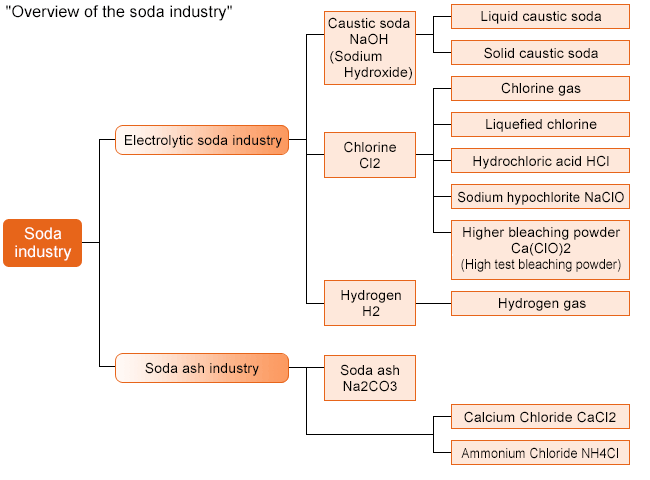- Home>
- Outline of the soda industry
Outline of the soda industry

The soda industry, one of the industrial segments providing basic industrial materials, produces from salt chemicals used as starting materials and reagents in a wide variety of industries. The soda industry in Japan consists of two branches: the electrolytic soda (chloralkali) industry, which manufactures caustic soda, chlorine, and hydrogen by the electrolysis of brine, and the soda ash industry, which manufactures soda ash by reacting salt with carbon dioxide and ammonia.
A prominent feature of the electrolytic soda industry is that the three totally different products, caustic soda, chlorine, and hydrogen, are produced at a constant ratio (1:0.886:0.025 by weight). This means that the market balance between these products, particularly of caustic soda and chlorine, with different outlets for each, must always to be taken into account for the healthy operation of the industry. Another feature is that electricity accounts for approximately 40% of the total production cost. In addition, Japan relies totally on imported salt for the starting material of the industry.
The products of the chloralkali process are caustic soda, chlorine, and hydrogen. Chlorine is, in addition to being directly used in the gaseous state, further processed into liquefied chlorine, hydrochloric acid, sodium hypochlorite, higher bleaching powder, and many other chlorine-based products.
The soda industry plays a significant role to improve the lives of the people. The chlorine-based products, caustic soda and soda ash, sometimes grouped as "soda products", find a wide range of direct or indirect applications in industry, and as such, are indispensable building block of modern life. This is why the development of the soda industry is regarded as one of the indexes for economic and industrial activity in a country.
The soda industry in Japan presently comprises 30 production sites of 24 manufacturing companies of electrolytic soda and 1 sites of 1 manufacturers of soda ash. They hire about 1,600 workers in total and produce a yearly value of about 340 billion yen. These figures become far greater if secondary and tertiary products which consume the soda products in manufacturing are taken into account.
Japan's chloralkali plants are either associated with petrochemical complexes or of relatively independent status. While the former group focuses on the chlorine supply for vinyl chloride production with large-scale production facilities, the latter provides caustic soda and chlorine products from plants of rather modest scale to local industries.
While being mature industries, Japan's electrolytic soda and soda ash industries have the most energy-efficient production facilities in the world, and are promoting pioneering technology developments.
The operation of Japanese chloralkali plants is controlled by the chlorine demand, which exceeds that of caustic soda, as in other industrialized countries. The balance of the products is struck by exporting caustic soda, as well as importing and exporting chlorine derivatives.
Since Japan's soda industry is sensitive to the world market trends for caustic soda, chlorine, salt, and electricity, a competitive edge in the global marketplace is the key to its survival.
